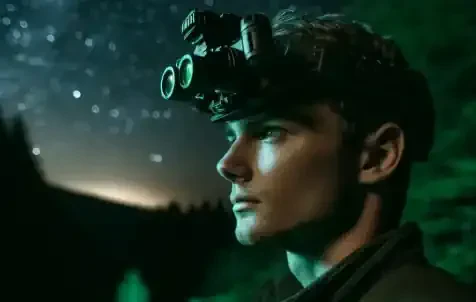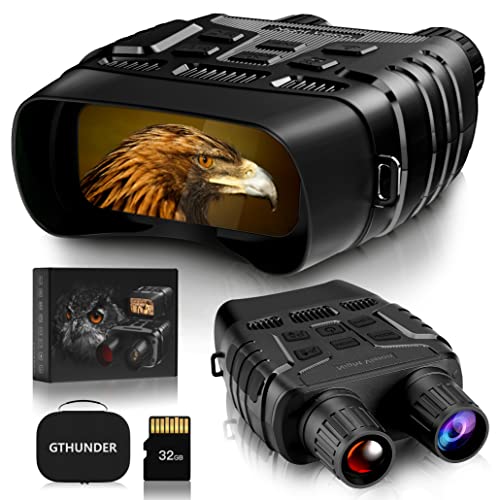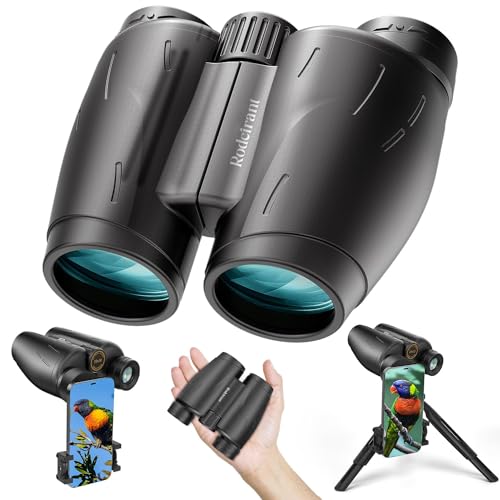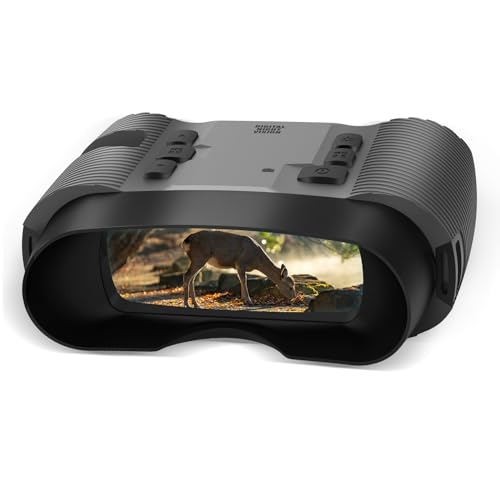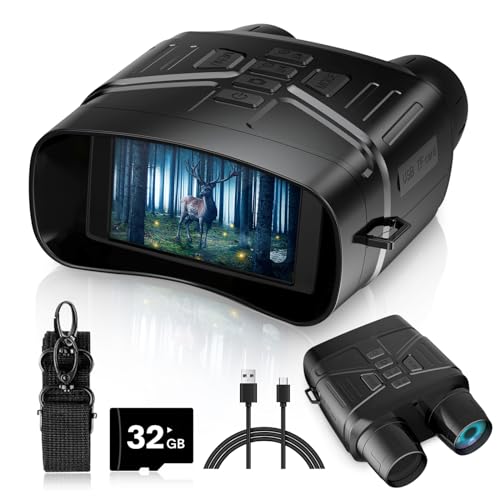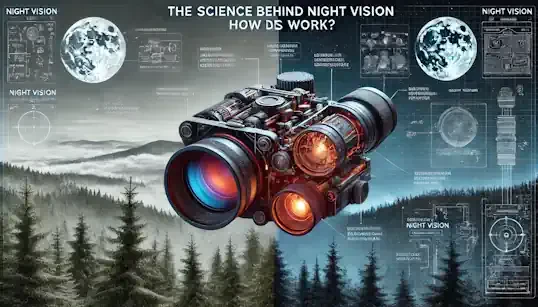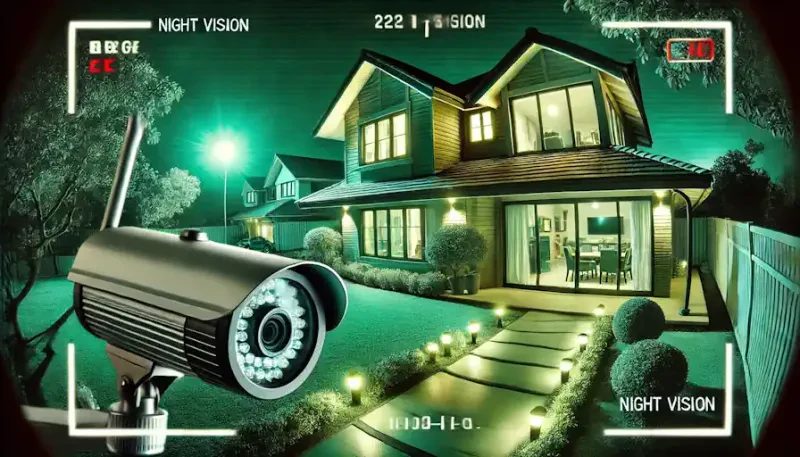Why Night Vision Is A Game-Changer For Outdoor Enthusiasts
Embarking on nighttime adventures opens up a whole new world of possibilities for those who love the great outdoors. Night vision gear isn't just about seeing in the dark; it's a transformative tool that enhances the entire outdoor experience. Whether you're a seasoned hiker, an avid camper, or a curious nature lover, night vision has the potential to revolutionize the way you connect with nature after sunset.
Experience Nature's Hidden Wonders: Wildlife, Stargazing, And More
The cover of darkness reveals a different side of nature, one teeming with nocturnal creatures and celestial spectacles. Night vision gear allows you to witness the secret lives of animals that rarely venture out during the day, from owls silently gliding through the air to elusive mammals foraging for food. Moreover, the night sky transforms into a breathtaking canvas for stargazing, revealing constellations, planets, and even the mesmerizing dance of the aurora borealis. With night vision, you become a privileged observer of these hidden wonders, gaining a deeper appreciation for the natural world's diversity and beauty.
Extend Your Adventures: Longer Days, More Exploration
Don't let the setting sun dictate the end of your outdoor pursuits. Night vision gear effectively extends your "daylight" hours, allowing you to continue hiking, camping, or exploring well into the night. This means you can tackle longer trails, reach remote destinations, or simply savor the tranquility of a moonlit wilderness. Imagine setting up camp under a starry sky, sharing stories around a campfire, or embarking on a night hike to catch a breathtaking sunrise from a mountaintop. Night vision empowers you to make the most of your time in nature, regardless of the hour.
Enhanced Safety: Navigate Tricky Terrain, Avoid Hazards
Navigating unfamiliar terrain in the dark can be challenging and potentially dangerous. Night vision gear provides a crucial advantage by illuminating your path and revealing hidden obstacles that could lead to trips, falls, or injuries. Whether you're traversing a rocky trail, crossing a stream, or setting up camp, night vision ensures you can move confidently and safely, minimizing the risk of accidents. Additionally, it allows you to spot potential hazards like wildlife or uneven ground, giving you ample time to react and make informed decisions. With night vision, you can explore with peace of mind, knowing you have a clear view of your surroundings.
Types of Night Vision: Choosing The Right Tool For Your Trek
Night vision technology isn't one-size-fits-all. It encompasses several distinct types, each with its own strengths, limitations, and ideal applications. Understanding these nuances is crucial for selecting the perfect tool to illuminate your nighttime adventures. Whether you're seeking enhanced visibility on a moonlit trail or aiming to spot wildlife in complete darkness, the right night vision device can make all the difference.
Image Enhancement Devices: Amplifying Existing Light
Image enhancement devices are the most common type of night vision gear, and they work by amplifying the available ambient light – be it moonlight, starlight, or even the faint glow of distant city lights. These devices utilize a technology called image intensifier tubes to capture and amplify photons, transforming even the dimmest light into a visible image. The resulting picture is typically green-hued, a characteristic of many night vision devices.
Monoculars Vs. Binoculars: Weighing The Options
Image enhancement devices come in two primary forms: monoculars and binoculars. Monoculars are compact and lightweight, ideal for those seeking a portable and affordable option. They offer a single lens for viewing and are often favored by hikers and campers who prioritize ease of use and minimal bulk. Binoculars, on the other hand, provide a wider field of view and enhanced depth perception, making them a popular choice for activities like wildlife observation and stargazing. However, they tend to be heavier and bulkier than monoculars.
Generations Of Technology: Understanding The Differences
Image enhancement devices are categorized into generations based on their technological advancements and image quality. Generation 1 devices are the most basic and affordable, but they offer limited image clarity and may experience some visual distortion. Generation 2 devices provide significant improvements in image resolution and light amplification, making them suitable for a wider range of activities. Generation 3 devices represent the pinnacle of image enhancement technology, delivering the highest image clarity, low-light performance, and overall viewing experience. However, they also come with a higher price tag.
Thermal Imaging: Detecting Heat Signatures
Thermal imaging devices take a different approach to night vision. Instead of relying on ambient light, they detect the heat signatures emitted by objects and living beings. This makes them incredibly effective in complete darkness, as they can clearly display the outlines of animals, people, and even terrain features based on temperature differences. Thermal imaging is particularly useful for wildlife observation, search and rescue operations, and navigation in challenging conditions.
Ideal For Wildlife Spotting And Navigation
Thermal imaging excels at revealing the presence of animals that would otherwise be invisible in the dark. Whether you're tracking elusive creatures or simply want to avoid surprising wildlife encounters, thermal imaging can provide a valuable layer of awareness. Moreover, it can aid navigation by highlighting terrain features like trails, rocks, and bodies of water, even in the absence of visible light.
Digital Night Vision: The Newest Technology
Digital night vision is a rapidly evolving technology that combines image enhancement with digital processing. These devices capture light through a digital sensor and then enhance the image using sophisticated algorithms. This results in high-resolution images with excellent clarity, even in low-light conditions. Some digital night vision devices also offer features like video recording, Wi-Fi connectivity, and zoom capabilities, making them versatile tools for both observation and documentation.
High-Resolution Images, Recording Capabilities
One of the key advantages of digital night vision is the ability to produce crisp, detailed images that surpass the resolution of traditional image enhancement devices. This is particularly beneficial for activities like wildlife photography, where capturing clear images in low light is essential. Additionally, many digital night vision devices allow you to record videos or take photos, enabling you to document your nighttime adventures and share them with others.
Essential Night Vision Gear For Camping And Hiking: Illuminating Your Path To Adventure
Having explored the various types of night vision technology, let's now turn our attention to the specific gear that can elevate your camping and hiking experiences after dark. From headlamps that light up the trail to specialized night vision goggles that reveal hidden details, equipping yourself with the right tools can transform your nocturnal explorations.
Headlamps: Hands-Free Illumination For Trails And Tasks
Headlamps are indispensable for any outdoor enthusiast venturing into the night. They offer hands-free illumination, freeing you to navigate trails, set up camp, cook meals, or simply read a map under the stars. Headlamps come in a vast array of styles and features, making it essential to choose one that aligns with your specific needs and preferences.
Lumen Output And Beam Distance: Matching To Your Needs
One of the most critical factors to consider when choosing a headlamp is its lumen output, which measures the brightness of the light emitted. For general camping and hiking, a headlamp with 200-400 lumens is often sufficient. However, if you plan to tackle technical trails or need to see further distances, opt for a headlamp with higher lumen output, ranging from 500 to 1000 lumens or more. Beam distance, measured in meters, is another crucial specification, determining how far the headlamp's light can reach. Consider the types of activities you'll be doing and the terrain you'll be navigating to determine the optimal beam distance for your headlamp.
Rechargeable Vs. Battery-Powered: Pros And Cons
Headlamps are typically powered by either rechargeable batteries or disposable batteries. Rechargeable headlamps are environmentally friendly and cost-effective in the long run, but they require access to a power source for recharging. Battery-powered headlamps offer convenience, as you can easily replace the batteries when they run out, but they can be less eco-conscious and may require carrying spare batteries on extended trips. Consider your personal preferences and the nature of your adventures when deciding which power source is right for you.
Night Vision Goggles And Monoculars: Expanding Your View
While headlamps provide focused illumination, night vision goggles and monoculars offer a wider field of view, allowing you to see more of your surroundings in low-light conditions. These devices are particularly valuable for activities like wildlife observation, stargazing, and navigating in unfamiliar terrain.
Choosing The Right Magnification And Field Of View
Night vision goggles and monoculars come with varying magnification levels, ranging from 1x to 10x or higher. Higher magnification allows you to see distant objects more clearly, but it can also narrow your field of view. Consider the type of activities you'll be doing to determine the ideal magnification level for your needs. Field of view, measured in degrees, refers to the width of the area you can see through the device. A wider field of view is generally preferred for activities like hiking and general observation, while a narrower field of view may be suitable for tasks requiring focused vision, such as wildlife spotting.
Comfort And Fit: Crucial For Extended Use
Comfort is paramount when choosing night vision goggles or monoculars, especially if you plan to wear them for extended periods. Look for devices with adjustable straps and padded eyepieces that provide a secure and comfortable fit. Consider the weight of the device as well, as heavier models may become cumbersome during long hikes or activities. Some night vision devices also offer head mounts, which can further enhance comfort and stability.
Infrared Illuminators: Boosting Visibility In Total Darkness
In situations where there's absolutely no ambient light, such as deep in a cave or on a moonless night, an infrared illuminator can be a valuable addition to your night vision gear. These devices emit infrared light, which is invisible to the human eye but can be detected by night vision devices. This allows you to see clearly in complete darkness, extending the capabilities of your night vision gear.
Optional Add-Ons For Certain Night Vision Devices
Infrared illuminators are typically optional accessories that can be attached to compatible night vision goggles or monoculars. Not all night vision devices require or are compatible with infrared illuminators, so it's important to check the specifications of your chosen device before purchasing one.
Understanding Range And Compatibility
Infrared illuminators have varying ranges, which determine how far the infrared light can reach and illuminate objects. Consider the distances you'll need to see to choose an illuminator with a suitable range. Additionally, ensure that the illuminator is compatible with your night vision device to ensure optimal performance.
Preparing For Your Nighttime Adventure: Gear Up, Plan Ahead, And Embrace The Darkness
Venturing into the wilderness after dark requires a different kind of preparation than daytime excursions. With the right planning, gear, and mindset, you can safely and confidently explore the enchanting world that emerges under the moon and stars. Let's delve into the essential steps to ensure your nighttime adventures are both enjoyable and safe.
Plan Your Route: Familiarize Yourself With The Terrain In Daylight
Before setting out on a night hike or camping trip, it's crucial to thoroughly familiarize yourself with the terrain during daylight hours. This allows you to identify potential hazards, challenging sections, and landmarks that may be difficult to discern in low-light conditions. Study maps, trail descriptions, and elevation profiles to gain a comprehensive understanding of the route. If possible, hike a portion of the trail during the day to gain firsthand experience and build confidence for your nighttime adventure.
Pack Essentials: Extra Batteries, Backup Light Sources, First-Aid Kit
Nighttime adventures demand a well-prepared pack. In addition to your night vision gear, be sure to carry extra batteries or charging cables for your headlamps and other electronics. Pack a backup light source, such as a handheld flashlight or a chemical light stick, in case your primary light fails. A comprehensive first-aid kit is also essential, containing supplies to address cuts, scrapes, blisters, and other minor injuries. Don't forget insect repellent, sunscreen, a whistle for signaling, and any personal medications you may need.
Dress For The Conditions: Layers For Warmth, Reflective Gear For Visibility
Temperatures can drop significantly after sunset, even during warmer months. Dress in layers to adapt to changing conditions, starting with a moisture-wicking base layer, followed by insulating mid-layers, and a waterproof and windproof outer shell. Don't forget to pack a warm hat and gloves, as extremities are particularly vulnerable to cold. Additionally, wearing reflective gear or clothing with high-visibility elements is crucial for safety. This will make you more visible to other hikers, cyclists, or vehicles that may be sharing the trail or road.
Practice Using Your Gear: Get Comfortable Before Heading Out
Before embarking on your nighttime adventure, take the time to thoroughly familiarize yourself with your night vision gear. Practice adjusting the settings, focusing the lenses, and switching between different modes. Get comfortable with the weight and feel of the device, especially if you'll be wearing it for extended periods. If you're using a headlamp, practice adjusting the beam angle and brightness to suit different tasks. The more comfortable you are with your gear, the more confident and enjoyable your nighttime experience will be.
Check Regulations: Some Areas Have Restrictions On Night Hiking
It's important to be aware of any regulations or restrictions regarding nighttime activities in the area you plan to visit. Some parks, forests, or wilderness areas may have specific rules about night hiking or camping, including designated hours or areas where these activities are permitted. Check with park rangers or land management agencies to ensure you're complying with all relevant regulations and to obtain any necessary permits.
Tips For Using Night Vision Gear Effectively: Master The Art Of Seeing In The Dark
Owning night vision gear is just the first step. To truly unlock its potential and make the most of your nighttime adventures, it's essential to master the techniques and nuances of using this technology effectively. By understanding its intricacies and following some simple tips, you can enhance your viewing experience, conserve battery life, and ensure your safety while exploring the world after dark.
Adjust Your Settings: Brightness, Contrast, Focus
Most night vision devices offer adjustable settings for brightness, contrast, and focus. Take the time to experiment with these settings in different lighting conditions to find the optimal configuration for your eyes and the environment. Avoid excessively bright settings, as they can cause eye fatigue and reduce overall visibility. Similarly, adjust the contrast to achieve a balance between highlighting details and preserving image clarity. Fine-tuning the focus is crucial for obtaining sharp images, especially when viewing objects at varying distances.
Scan Slowly And Methodically: Avoid Eye Fatigue
When using night vision, resist the urge to quickly scan your surroundings. Instead, move your eyes slowly and deliberately, allowing your brain to process the information it receives. Rapid scanning can strain your eyes and make it harder to discern details. Focus on specific areas of interest, such as the trail ahead, potential obstacles, or wildlife movement. By adopting a patient and methodical approach, you can maximize your visual acuity and reduce eye fatigue.
Be Aware Of Limitations: Range, Field Of View, Battery Life
While night vision technology is remarkably advanced, it does have its limitations. Understanding these limitations is key to using your gear effectively and avoiding disappointment. Each night vision device has a specific range, which determines how far it can effectively see in different lighting conditions. Be aware of this range and adjust your expectations accordingly. Similarly, consider the device's field of view, as this dictates how much of your surroundings you can see at once. Lastly, be mindful of battery life, especially on extended outings. Carry spare batteries or charging cables to ensure you have enough power to last throughout your adventure.
Use Red Light: Preserves Night Vision Adaptation
When using a headlamp or other light source in conjunction with night vision, opt for red light whenever possible. Red light has a longer wavelength than other colors, making it less likely to interfere with your night vision adaptation. This means your eyes can adjust more quickly to the darkness when you switch back to using your night vision device. Many headlamps offer red light modes specifically for this purpose. If yours doesn't, you can purchase a red light filter to attach to your headlamp.
Safety First: Nighttime Hiking And Camping Precautions: Navigating The Darkness With Confidence
While night vision technology empowers exploration, venturing into the wilderness after dark demands a heightened awareness of safety. The absence of daylight brings unique challenges and potential hazards, making it imperative to prioritize caution and preparedness. By following these essential safety tips, you can mitigate risks, ensure a secure experience, and fully enjoy the magic of nighttime adventures.
Hike With A Partner: Buddy System For Added Security
Whenever possible, hike or camp with a companion during nighttime excursions. The buddy system provides an extra layer of safety, as you can look out for each other, share the responsibility of navigation, and offer assistance in case of emergencies. If one person becomes injured or disoriented, the other can provide support and summon help if needed. Additionally, hiking with a partner can boost morale and make the experience more enjoyable.
Tell Someone Your Plans: Leave An Itinerary With A Trusted Contact
Before embarking on any nighttime adventure, inform a trusted friend or family member about your plans. Share your itinerary, including your intended route, estimated arrival time, and expected return. This way, someone knows where you are and when to expect you back. In case of unforeseen circumstances or delays, this information can be crucial for initiating search and rescue efforts if necessary.
Carry A Map And Compass: Backup Navigation In Case Of Tech Failure
While GPS devices and smartphone apps are convenient navigation tools, they are not infallible. Batteries can die, signals can be lost, and technical glitches can occur. Therefore, it's essential to carry a physical map and compass as a backup. Learn how to use them proficiently, as they can be lifesavers in situations where technology fails. Familiarize yourself with the terrain and key landmarks before setting out, and use the map and compass to track your progress and ensure you stay on course.
Stay On The Trail: Avoid Getting Lost In Unfamiliar Terrain
Navigating in the dark can be disorienting, even with night vision gear. To minimize the risk of getting lost, it's crucial to stay on established trails. Avoid venturing off-trail, as this can lead to confusion, injuries, and potential encounters with hazards. If you must leave the trail for any reason, mark your path with cairns or other visible markers to ensure you can easily find your way back.
Be Aware Of Wildlife: Respect Their Space, Make Noise To Alert Them
Nighttime is when many wild animals are most active, so be prepared for potential encounters. Research the types of wildlife that inhabit the area you'll be visiting and learn about their behaviors. Respect their space and avoid approaching them, especially if they appear agitated or defensive. Making noise while hiking, such as talking or singing, can alert animals to your presence and prevent surprise encounters. Carry bear spray if you're in bear country and be prepared to use it if necessary.
By adhering to these safety precautions, you can minimize risks and ensure a safe and enjoyable nighttime adventure. Remember, the wilderness at night holds a unique allure, but it also demands respect and caution.
Stargazing With Night Vision: A Celestial Spectacle Beyond The Naked Eye
Night vision isn't just for navigating trails or spotting wildlife; it opens a gateway to a whole new universe of wonder – the night sky. When you peer into the cosmos through night vision devices, the stars, planets, and celestial phenomena become vividly clear, offering an awe-inspiring perspective that transcends the limitations of the naked eye. Let's explore how night vision can elevate your stargazing experiences and unveil the hidden treasures of the night sky.
Finding The Right Spot: Dark Skies Away From Light Pollution
To maximize the impact of your stargazing sessions, it's crucial to choose a location with minimal light pollution. Urban areas with their bright lights can significantly obscure the fainter stars and celestial objects. Seek out remote locations, such as national parks, wilderness areas, or designated dark sky preserves, where the darkness is profound and the stars shine with unparalleled brilliance. Researching dark sky maps and light pollution forecasts can help you pinpoint the most promising spots for your celestial explorations.
Identifying Constellations And Planets: Use Star Charts And Apps
While night vision enhances visibility, it's still helpful to have some guidance when navigating the night sky. Star charts, either physical or digital, can be invaluable tools for identifying constellations, planets, and other celestial objects. These charts map out the positions of stars and celestial bodies, allowing you to pinpoint their locations and learn about their names and mythological significance. Many smartphone apps offer augmented reality features that overlay star charts onto the live view from your camera, making it even easier to identify constellations and track their movements across the sky.
Capturing The Moment: Night Vision Photography Tips
Night vision devices aren't just for looking; they can also be used to capture stunning photos and videos of the night sky. With the right equipment and techniques, you can immortalize the beauty of the cosmos in breathtaking detail. If you're using a digital night vision device, experiment with its settings to find the optimal exposure and ISO for capturing clear and vibrant images. Consider using a tripod to stabilize your shots and reduce blur, especially when shooting with longer exposure times. For those with a passion for astrophotography, dedicated night vision cameras are available, offering even greater control and image quality.
Night Vision For Wildlife Observation: Witnessing Nature's Nocturnal Ballet
Night vision technology opens a window into the secret world of nocturnal creatures, offering unparalleled opportunities for wildlife observation. From observing elusive predators on the hunt to witnessing the playful antics of nocturnal mammals, night vision allows you to immerse yourself in the intricate ballet of nature after dark. Let's explore how this technology can transform your wildlife encounters and deepen your understanding of the animal kingdom's nocturnal rhythms.
Spotting Nocturnal Animals: Owls, Coyotes, Raccoons, And More
Equipped with night vision, you can become a silent observer of the fascinating creatures that emerge under the cover of darkness. Owls, with their silent flight and piercing gaze, become visible as they swoop down to capture their prey. Coyotes, foxes, and other canids reveal their hunting strategies and social interactions as they roam through the night. Raccoons, skunks, and opossums scavenge for food, their movements illuminated by the gentle glow of your night vision device. Even elusive creatures like bobcats and mountain lions may reveal themselves, offering a rare glimpse into their secretive lives.
Ethical Considerations: Minimize Disturbance, Observe From A Distance
While night vision allows for closer observation of wildlife, it's crucial to prioritize ethical considerations. Always observe animals from a distance and avoid disturbing their natural behaviors. Bright lights, sudden movements, and loud noises can frighten animals and disrupt their feeding, mating, or nesting activities. Remember that you're a guest in their habitat, and your goal is to observe them without causing stress or harm.
Choosing The Right Gear: Thermal Vs. Image Enhancement
The type of night vision gear you choose can significantly impact your wildlife observation experiences. Image enhancement devices are ideal for observing animals in environments with some ambient light, such as moonlit nights or areas with minimal light pollution. They provide a clear view of the animal's physical features and movements, allowing you to appreciate their unique characteristics. Thermal imaging devices, on the other hand, excel in complete darkness, as they detect the heat signatures emitted by animals. This is particularly useful for spotting animals that are well-camouflaged or hidden in dense vegetation.
By combining the power of night vision technology with ethical observation practices, you can unlock a world of nocturnal wildlife wonders and deepen your appreciation for the intricate web of life that thrives after dark. Whether you're tracking the movements of a stealthy predator or simply enjoying the playful antics of a nocturnal mammal, night vision allows you to witness nature's nocturnal ballet in all its glory.
Beyond Camping And Hiking: Other Uses For Night Vision: Expanding Your Horizons After Dark
While camping and hiking enthusiasts readily embrace night vision technology, its applications extend far beyond the trails and campsites. Night vision devices have found their way into diverse fields, enhancing activities ranging from recreational pursuits to professional endeavors. Let's explore some of the fascinating and unexpected ways night vision is being utilized to navigate, explore, and safeguard our world after dark.
Fishing: Spotting Fish In Murky Water, Navigating At Night
Anglers are increasingly turning to night vision to gain an edge on the water. In murky or low-light conditions, night vision can reveal the subtle movements of fish beneath the surface, allowing anglers to cast their lines with greater precision. Additionally, night vision aids navigation, enabling boaters to safely navigate waterways, identify obstacles, and avoid hazards after sunset. Whether you're casting a line for bass under a moonlit sky or embarking on a nighttime fishing expedition, night vision can significantly enhance your angling success and safety.
Boating: Enhancing Visibility On The Water After Dark
Boating enthusiasts, too, benefit from the increased visibility and situational awareness provided by night vision. On the open water, darkness can obscure obstacles, other vessels, and navigational markers, making navigation challenging and potentially dangerous. Night vision devices, whether mounted on the boat or worn by the operator, illuminate the path ahead, reveal potential hazards, and aid in identifying other boats or floating debris. This enhanced visibility contributes to safer nighttime boating experiences, allowing boaters to enjoy their time on the water with confidence.
Search And Rescue: Locating Lost Hikers, Finding Missing Persons
Night vision has become an invaluable tool for search and rescue teams operating in low-light or nighttime conditions. When searching for lost hikers, missing persons, or even downed aircraft, the ability to see clearly in the dark can mean the difference between life and death. Night vision devices enable search and rescue personnel to scan vast areas quickly and efficiently, identifying heat signatures or subtle movements that may indicate the presence of a person in need of assistance. In remote or wilderness areas, where darkness can quickly descend, night vision is a critical asset for locating and rescuing individuals in distress.
Home Security: Monitoring Property, Detecting Intruders
Beyond recreational and professional applications, night vision has also found its way into the realm of home security. Many homeowners are investing in night vision cameras and surveillance systems to monitor their property and deter potential intruders after dark. These devices provide clear, high-resolution images even in low-light conditions, allowing homeowners to identify and respond to potential threats quickly and effectively. Whether it's monitoring a dark backyard, a remote driveway, or a vulnerable entry point, night vision enhances home security and provides peace of mind.
The versatility of night vision technology continues to expand, with new and innovative applications emerging across various industries. As advancements in technology make night vision devices more accessible and affordable, we can expect to see even more creative and impactful uses for this powerful tool in the years to come. Whether it's exploring the depths of the ocean, assisting law enforcement in tactical operations, or simply illuminating our backyards, night vision is transforming the way we see and interact with the world after dark.
The Future Of Night Vision: A Glimpse Into The Technologies Of Tomorrow
As with all technology, the world of night vision is constantly evolving. The future holds exciting possibilities for further advancements and innovations, promising even more sophisticated, accessible, and versatile night vision devices. Let's take a peek into what the future might hold for this transformative technology.
Smaller, Lighter, More Affordable Devices
The bulky and expensive night vision devices of the past are gradually giving way to smaller, lighter, and more affordable options. Advancements in materials science and manufacturing techniques are paving the way for compact and lightweight devices that are easier to carry and use during outdoor adventures. As production costs decrease, we can expect night vision technology to become more accessible to a wider range of consumers, allowing more people to experience the thrill of seeing in the dark.
Improved Image Quality And Battery Life
Image quality is a paramount concern for night vision users, and ongoing research is continuously pushing the boundaries of what's possible. The future holds the promise of even higher resolution images, enhanced contrast, and improved low-light performance. Additionally, advancements in battery technology are likely to result in longer battery life, enabling extended use without the need for frequent recharging or battery replacements. These improvements will not only enhance the user experience but also expand the potential applications of night vision across various fields.
Augmented Reality Overlays: Information Displayed On Your View
One of the most exciting prospects for the future of night vision is the integration of augmented reality (AR) overlays. Imagine having real-time information about your surroundings, such as trail markers, distances, elevation changes, or even wildlife identification, displayed directly onto your field of view. This technology would revolutionize navigation, enhance situational awareness, and provide a wealth of educational information to users. While still in its early stages, AR overlays have the potential to transform night vision from a simple viewing tool into a multi-functional information platform.
Integration With Other Technologies: GPS, Smartphones, Drones
Night vision technology is also poised to integrate more seamlessly with other technologies we use daily. We can anticipate the integration of GPS functionality into night vision devices, providing real-time location tracking and navigation assistance. Additionally, smartphone connectivity could enable users to control device settings, share images and videos, and access a wider range of information directly through their mobile devices. The possibilities for integration are vast, and we may even see night vision cameras integrated into drones, offering a unique aerial perspective for surveillance, search and rescue operations, and even filmmaking.
